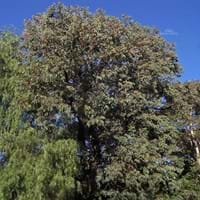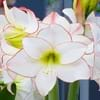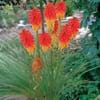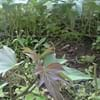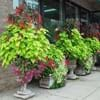Life Span
Perennial
Annual and Perennial
Type
Bulb or Corm or Tuber
Tree
Origin
Hybrid origin
Australia
Types
Not Available
Not Available
Habitat
tropical environments
gardens, Mountain tops, Open Forest, Roadsides, Tropical regions, Woodlands
USDA Hardiness Zone
8-11
9-11
AHS Heat Zone
Not Available
12-3
Sunset Zone
21,22
H1, H2, 5, 6, 8, 9, 10, 11, 12, 13, 14, 15, 16, 17, 18, 19, 20, 21, 22, 23, 24
Habit
Clump-Forming
Upright/Erect
Flower Color
White, Red, Light Pink
White, Pink, Rose
Flower Color Modifier
Bicolor
Bicolor
Fruit Color
Green, Brown
Green, Light Pink
Leaf Color in Spring
Green, Dark Green
Gray Green
Leaf Color in Summer
Light Green
Gray Green
Leaf Color in Fall
Several shades of Green
Gray Green
Leaf Color in Winter
Light Green
Gray Green
Leaf Shape
Long Linear
Oblong
Plant Season
Spring, Summer, Winter
Spring, Summer, Fall, Winter
Sunlight
Full Sun, Partial Sun
Full Sun
Type of Soil
Loam, Sand
Clay, Loam, Sand
The pH of Soil
Acidic, Neutral
Acidic, Neutral, Alkaline
Soil Drainage
Well drained
Well drained
Bloom Time
Not Available
Early Spring, Spring, Late Spring, Winter, Late Winter
Tolerances
Deer resistant
Pollution, Drought, Salt, Soil Compaction
Where to Plant?
Container, Ground, Pot
Ground
How to Plant?
Divison, From Rhizomes, Tubers
Seedlings, Stem Planting
Plant Maintenance
Low
Medium
Watering Requirements
Average Water Needs
Requires watering in the growing season, Use Mulches to help prevent water loss during hot and windy weather, Water Deeply
In Summer
Lots of watering
Lots of watering
In Spring
Moderate
Moderate
In Winter
Average Water
Average Water
Soil pH
Acidic, Neutral
Acidic, Neutral, Alkaline
Soil Type
Loam, Sand
Clay, Loam, Sand
Soil Drainage Capacity
Well drained
Well drained
Sun Exposure
Full Sun, Partial Sun
Full Sun
Pruning
Cut or pinch the stems, Remove damaged leaves, Remove dead branches, Remove dead leaves
No pruning needed, Remove dead leaves, Remove deadheads
Fertilizers
as it is a flowering plant, use high phosphorous content fertilizer, Nitrogen, Phosphorous, Potassium, Requires high amount of nitrogen
All-Purpose Liquid Fertilizer
Pests and Diseases
Aphids, Grasshoppers, Mealybugs, Mites, Red blotch, Slugs, Snails
Pests and diseases free
Plant Tolerance
Deer resistant
Drought, Pollution and Soil Compaction, Salt
Flower Petal Number
Not Available
Single
Edible Fruit
Not Available
No
Fragrant Flower
Not Available
No
Fragrant Bark/Stem
No
Yes
Foliage Texture
Medium
Medium
Foliage Sheen
Glossy
Matte
Attracts
Bees, Butterflies, Hummingbirds
Hummingbirds
Allergy
poisonous if ingested
no allergic reactions
Aesthetic Uses
Beautification, Bouquets, Cottage Garden, Showy Purposes
Not Used For Aesthetic Purpose
Beauty Benefits
Not Available
Not Available
Environmental Uses
Not Available
Air purification
Medicinal Uses
Not Available
Cold
Part of Plant Used
Flowers
Bark, Leaves
Other Uses
Used as Ornamental plant, Used for bedding in gardens
Medicinal oil, Used as firewood, Wood is used for making furniture, Wood is used for ship building
Used As Indoor Plant
Yes
No
Used As Outdoor Plant
Yes
Yes
Garden Design
Container, Cutflower, Houseplant, Mixed Border, Tropical
Feature Plant, Screening / Wind Break, Shade Trees
Botanical Name
HIPPEASTRUM 'Picotee'
EUCALYPTUS sideroxylon
Common Name
Florist Amaryllis, Hippeastrum, Picotee Hippeastrum
Ironbark
In Hindi
HIPPEASTRUM
Ironbark
In German
HIPPEASTRUM
Ironbark
In French
HIPPEASTRUM
Ironbark
In Spanish
Hippeastrum
Ironbark
In Greek
Hippeastrum
Ironbark
In Portuguese
HIPPEASTRUM
Ironbark
In Polish
Hippeastrum
Ironbark
In Latin
Hippeastrum
Ironbark
Phylum
Magnoliophyta
Not Available
Class
Magnoliopsida
Not Available
Order
Asparagales
Myrtales
Family
Amaryllidaceae
Myrtaceae
Genus
Amaryllis
Eucalyptus
Clade
Angiosperms, Monocots
Angiosperms, Eudicots, Rosids
Tribe
Not Available
Eucalypteae
Subfamily
Amaryllidoideae
Myrtoideae
Season and Care of Hippeastrum and Ironbark
Season and care of Hippeastrum and Ironbark is important to know. While considering everything about Hippeastrum and Ironbark Care, growing season is an essential factor. Hippeastrum season is Spring, Summer and Winter and Ironbark season is Spring, Summer and Winter. The type of soil for Hippeastrum is Loam, Sand and for Ironbark is Clay, Loam, Sand while the PH of soil for Hippeastrum is Acidic, Neutral and for Ironbark is Acidic, Neutral, Alkaline.
Hippeastrum and Ironbark Physical Information
Hippeastrum and Ironbark physical information is very important for comparison. Hippeastrum height is 38.10 cm and width 30.10 cm whereas Ironbark height is 910.00 cm and width 760.00 cm. The color specification of Hippeastrum and Ironbark are as follows:
Hippeastrum flower color: White, Red and Light Pink
Hippeastrum leaf color: Green and Dark Green
Ironbark flower color: White, Pink and Rose
- Ironbark leaf color: Gray Green
Care of Hippeastrum and Ironbark
Care of Hippeastrum and Ironbark include pruning, fertilizers, watering etc. Hippeastrum pruning is done Cut or pinch the stems, Remove damaged leaves, Remove dead branches and Remove dead leaves and Ironbark pruning is done No pruning needed, Remove dead leaves and Remove deadheads. In summer Hippeastrum needs Lots of watering and in winter, it needs Average Water. Whereas, in summer Ironbark needs Lots of watering and in winter, it needs Average Water.

